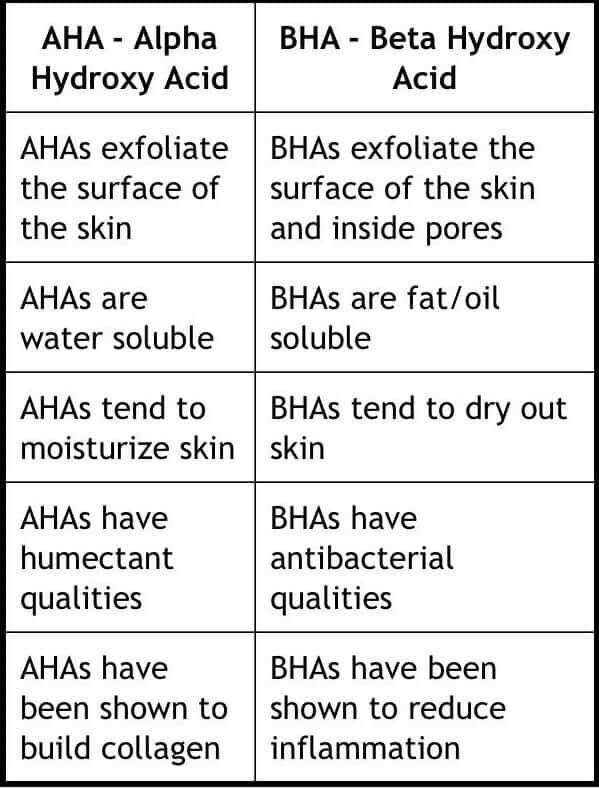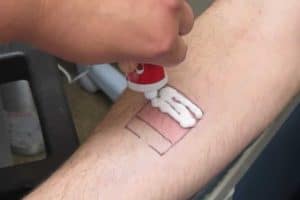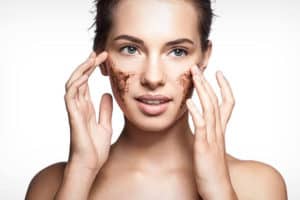More and more, AHAs (alpha hydroxy acids) and BHAs (beta hydroxy acids) are growing in popularity in the skincare world. Each acid is beneficial for the skin in its own way, but what about combined?
Can you use AHA and BHA together? You can use AHA and BHA together on your skin, but it’s generally not recommended. AHA and BHA are both powerful exfoliants.
If they are used together, they must be mixed with the right percentage to not over-exfoliate and harm your skin. Use them separately so as to not risk over-exfoliating and harming your skin.
Read on to learn more about AHAs and BHAs and using them both together.
Can You Use AHA and BHA Together?
AHAs have the ability to hydrate dry and aging skin because they are water-soluble, while BHAs can penetrate deeper into the hair follicles to clean your skin pores, as they are oil-soluble.
With these properties, AHAs can loosen and exfoliate dry skin surface cells, and BHAs can unclog pores to allow your skin to breathe.
AHA and BHA can be used together at the same time to exfoliate and cleanse your skin, but you risk over-exfoliating. Both types of acids are powerful, active ingredients.
Layering an AHA with a BHA together can strip your skin of its natural oils. It can result in dryness, irritation, redness, irritation, and maybe even burn the skin.
Some people with strong enough skin could tolerate using both AHA and BHA together, but it would be too risky for most skin types. Especially if you have sensitive skin, even if you combine the two acids with the right percentage amounts – together, they will be too harsh for your sensitive skin.
One of the big advantages of using AHAs and BHAs separately, not together, is that you can treat different skin areas according to their specific condition. You can use salicylic on the oily portion of your face, while you can use glycolic on the dry portion of your face.
It is convenient if you use a product that combines AHAs and BHAs, but the risks of over-exfoliating and irritation outweigh the convenience. You can try for yourself, but test products with both only on a small patch of your skin.
I also want to caution that if you use AHAs and BHAs together, your skin will be much more sensitive to the sun. FDA-initiated studies revealed that exposure of skin treated with AHAs or BHAs to the ultraviolet rays of the sun can increase the risk of skin damage or sunburns.
So if you do use AHAs and BHAs together, you’ll need to ensure you avoid the sun, cover up, and use a very strong SPF sunscreen.
The below chart shows a break down of the differences between AHAs and BHAs. It can look convenient to use both, so get the benefits of both all at once, but this can spell trouble for your skin as they are too powerful on their own and together will irritate and over-exfoliate.

Types of AHAs
Glycolic Acid
Glycolic acid is derived from natural products, such as sugar cane and other organic sources. It can help exfoliate the skin to eliminate lines and wrinkles. Furthermore, it acts as an antimicrobial agent to treat acne, discoloration, psoriasis, keratosis, and other skin conditions.
Try the Malin + Goetz 10% Glycolic Acid Pads for a product that has a good starting level of glycolic acid at 10%. This easy-to-use at-home exfoliating treatment removes dead skin cells, boosts collagen production, and improves the overall clarity and texture of your skin.
Citric Acid
Citric acid comes from citrus fruits, namely limes and lemons. It is commonly added to products such as sunscreens, toners, and serum preparations. Sunscreens may be more effective with the presence of citric acid as the citric acid helps in maintaining the normal pH (acidity and alkalinity) of the skin. Sometimes, citric acid is classified as a BHA, depending on its preparation.
This neutralizing action of citric acid evens out the color of the skin, so it becomes smoother. Citric acid is also an excellent base for your skin before applying your make-up.
Lactic Acid
Lactic acid is derived from yogurt or sour milk. It enhances the skin’s natural moisture and keeps the skin cells hydrated and healthy. So it’s excellent as an exfoliating agent for dry skin. It has the ability to do this in a gentler manner than other AHAs. Cell turnover is accelerated by lactic acid, making it easier for the skin to generate new skin cells.
Try the DRMTLGY Lactic Acid 12% Refining Serum for Face from Amazon:
Mandelic Acid
The cosmetic industry obtains its mandelic acid from bitter almonds. Mandelic acid acts as an anti-aging, collagen-boosting ingredient in skin exfoliators. Acting as a collagen-booster, it gets rid of dead skin cells quickly, removes lines, and eliminates wrinkles. It’s an excellent ingredient for the eradication of hyperpigmentation, discoloration, and acne.
Tartaric Acid
Tartaric acid is an essential alpha hydroxy acid that comes from grape wine and tamarinds. It’s incorporated into skin exfoliators as it can trigger collagen production and give the skin a firmer, more elastic texture. It helps in shedding dead skin cells, thereby reducing wrinkles, lines, and aging.
Malic Acid
Malic acid is derived from apples. It decreases the production of melanin (a skin pigment), and thus, is incorporated into skin products to treat hyperpigmentation or skin discoloration. Like many other AHAs, malic acid rejuvenates the skin by boosting collagen production.
Types of BHAs
Salicylic Acid
Salicylic acid or its derivatives – e.g., salicylates, willow bark extract – is the most common and most effective BHA. Since it is oil-soluble, it can pass through the lipid layers of the skin to enter the roots of skin hair follicles (pores) and loosen dead skin cells.
The old skin cells are then disposed of, so new cells can take their place. It’s used for treating blackheads, whiteheads, acne, hyperpigmentation, and other skin conditions.
Try Skin Beauty Solutions Salicylic Acid 30% Chemical Peel with Beta Hydroxy BHA from Amazon. It is a highly effective chemical peeling product that will reduce the oil on your skin and clean the pores, leaving you with healthy, radiant skin.
The other BHAs, such as Beta Hydroxybutanoic Acid and Trethocanic Acid, are not commonly used for skincare use.
For an AHA and BHA product kit, see Paula’s Choice Skin Perfecting 8% AHA Gel Exfoliant and 2% BHA Liquid Duo. This Duo-Facial Exfoliant Pack includes the AHA and BHA separately, so you can use them on different parts of your face and body and in different amounts.
This duo hydrates your skin while gently eliminating dead skin cells. It also evens out skin tone, removes wrinkles, and reduces enlarged pores, making your skin younger and rejuvenated.
See the below video to learn more about AHAs and BHAs, and can you use AHA and BHA together:
Recommendations from Experts on Combing AHA and BHA
Most experts do not recommend using both AHA and BHA at the same time. Dr. Caren Campbell, MD, a board-certified dermatologist in San Francisco, says, “These acids (AHA and BHA) help clear dead skin cells from the pores and also kill acne-causing bacteria.
They can be used together for some skin types but would be very drying and irritating for most. In my opinion, acids offer the most benefit when used on their own.”
Cosmetic Ingredient Review Director Alan Andersen and his expert panel concluded in their evaluation that “the use of salicylic acid in cosmetics is safe.” But they advised not to combine it with other acids and warned users of increased sun sensitivity.
Cosmetic manufacturers are also required to determine the effect of UV exposure on their products. Consequently, users of skin products containing AHAs and BHAs are advised to follow the instructions on the products’ labels carefully.
For users, the skin product has to be tested first on a small area of the user’s skin before use. If allergic reactions occur, the product must not be used.
To ascertain that skin damage does not occur, sunscreens must be used. Special warning also prohibits children and infants from using products containing these acids. [1]
A study conducted by Eskandar Moghimipour, a Pharmacy Faculty in the Ahvaz Jundishapur University of Medical Sciences in Iran, reported that hydroxy acids are the most widely used anti-aging preparations.
According to his findings, because of the oil solubility of salicylic acid, it is appropriate for oily skin. Moghimipour further reported that salicylic concentrations of 1% to 2 % work best with skin care products when used alone, without the use of other acids. [2]
Another study that compared the effects of varying percentages of AHAs found out that 5% concentration can affect epidermal changes only, while a 12% preparation was able to affect the epidermis and the dermis.
Thus, the proper percentages could render a significant improvement on the effects of these acids. It also indicates that AHAs and BHAs can be used together, but it is important to ensure they are in the right percentages or the combination will be too strong.
Conclusion – Can You Use AHA and BHA Together?
Can you use AHA and BHA together? You can certainly use AHAs and BHAs together as they can enhance each other’s beneficial effects on the skin. However, keep tabs on the proper percentages of each component.
Studies have recommended that 1 to 2% of salicylic acid (BHA) mixed with 10% of glycolic acid (AHA) is the ideal ratio.
AHAs and BHAs give you smoother, youthful skin, free of wrinkles, acne, lines, and pimples. They can treat hyperpigmentation, keratosis, discoloration, psoriasis, and other skin conditions.
The AHA will act on the epidermis of your skin to get rid of dead skin cells. It will hydrate your skin cells, activate the production of collagen, and will enhance new cell synthesis.
On the other hand, the BHA will penetrate deeper into the dermis of your skin and loosen sebum or materials that clog the pores. Cleaner pores will considerably reduce the breakout of pimples and acne.
Related Questions
What is the best AHA and BHA to use on the skin? The best AHA is glycolic acid, as it’s the smallest and the most bioavailable. The best BHA is salicylic acid, as it targets the lower level of the dermis to clean out the pores.
Salicylic acid is also considered the safest BHA due to the fact that it has been extensively tested for its side effects. When used in proper concentrations, they are safe when used as skin care products.
Do I need sunscreen when using AHA and BHA? Yes, you need a reliable sunscreen to prevent the ultraviolet rays of the sun from damaging your skin. Reportedly, skin treated with AHAs and BHAs becomes more susceptible to UV exposure.
AHA vs. BHA: which one is more effective? Both are effective on their own, as they have specific functions as peeling agents. AHA works on the surface of the skin, while BHA reaches deeper layers. Together, they are an ideal skin care preparation.
Related reading:
Can You Use Glycolic Acid and Retinol Together?
Can You Use Glycolic Acid and Vitamin C Together?
Can You Use Glycolic Acid and Salicylic Acid Together?






